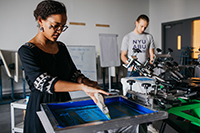
Jay Lee, Class of 2022
History Major with a Minor in
Psychology
Falconry with Professor Anne-Lise Tropato (CCEA)
The research that was integrated with the course was actually the professor's own
project. She wanted to develop a database of artistic representations of falconry
around the world across various time periods...Personally, being part of this
research project has been immensely helpful. It really taught me to think outside
the box of finding new sources and integrating them into the research. For example,
I've only understood falconry in a European context, but I took the contents of the
class and applied it to the research process. I began looking for artworks of
falconry in the Middle East, the Americas, and even to my home country Korea. As I
found a lot of sources that show falconry represented in Korea, I got more in touch
with my country's culture and history, so it was even more meaningful for me”




